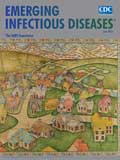full-text â–º see below
Medscape CME Activity – Vol. 19 No. 6 – June 2013 – Emerging Infectious Disease journal – CDC
 

CME Articles
Volume 19, Number 6–June 2013
Volume 19, Number 6—June 2013
CME ACTIVITY
Iatrogenic Blood-borne Viral Infections in Refugee Children from War and Transition Zones
This activity has been planned and implemented in accordance with the Essential Areas and policies of the Accreditation Council for Continuing Medical Education through the joint sponsorship of Medscape, LLC and Emerging Infectious Diseases. Medscape, LLC is accredited by the ACCME to provide continuing medical education for physicians.
Medscape, LLC designates this Journal-based CME activity for a maximum of 1 AMA PRA Category 1 Credit(s)TM. Physicians should claim only the credit commensurate with the extent of their participation in the activity.
All other clinicians completing this activity will be issued a certificate of participation. To participate in this journal CME activity: (1) review the learning objectives and author disclosures; (2) study the education content; (3) take the post-test with a 70% minimum passing score and complete the evaluation at www.medscape.org/journal/eid
Learning Objectives
Upon completion of this activity, participants will be able to:
CME Editor
Karen L. Foster, Technical Writer/Editor, Emerging Infectious Diseases. Disclosure: Karen L. Foster has disclosed no relevant financial relationships.
CME Author
Laurie Barclay, MD, freelance writer and reviewer, Medscape, LLC. Disclosure: Laurie Barclay, MD, has disclosed no relevant financial relationships.
Authors
Disclosure: Paul Goldwater, MD, has disclosed no relevant financial relationships.
  

CME Articles
Volume 19, Number 6–June 2013
full-text â–º large
Iatrogenic Blood-borne Viral Infections in Refugee Children from War and Transition Zones – Vol. 19 No. 6 – June 2013 – Emerging Infectious Disease journal – CDC
Volume 19, Number 6—June 2013
CME ACTIVITY
Iatrogenic Blood-borne Viral Infections in Refugee Children from War and Transition Zones
Article Contents
- Medscape CME Activity
- Methods and Definitions
- Case Reports
- Discussion of Cases
- Modes of Transmission Contributing to Increased BBV Prevalence
- Implications and the Future
- Acknowledgment
- References
- Table
- Suggested Citation
Suggested citation for this article
Abstract
Pediatric infectious disease clinicians in industrialized countries may encounter iatrogenically transmitted HIV, hepatitis B virus, and hepatitis C virus infections in refugee children from Central Asia, Southeast Asia, and sub-Saharan Africa. The consequences of political collapse and/or civil war—work migration, prostitution, intravenous drug use, defective public health resources, and poor access to good medical care—all contribute to the spread of blood-borne viruses. Inadequate infection control practices by medical establishments can lead to iatrogenic infection of children. Summaries of 4 cases in refugee children in Australia are a salient reminder of this problem.
Blood-borne viruses (BBVs) have benefitted from internal political strife, migration, prostitution, intravenous/injection drug use, and defective public health resources in some Central Asian republics and Southeast Asian and sub-Saharan African countries. Iatrogenic transmission of HIV in children in Romania (1) and the Russian republic of Kalmykia (2) are well-known examples. Refugee children are a special risk category for infection with BBVs (3). When iatrogenic transmission was encountered in a pediatric infectious diseases clinic in Adelaide, South Australia, Australia, concern was raised about whether it was an isolated or a more widespread phenomenon.
The United Nations High Commissioner for Refugees estimates that there were 43.7 million forcibly displaced persons worldwide at the end of 2010, the highest number in 15 years. Of these, 27.5 million were internally displaced persons, 15.4 million were refugees, and 837,500 were asylum seekers (4). Children constituted more than half of the humanitarian refugee population in Australia (5). A refugee is legally defined as a person who is outside his or her country of nationality and is unable to return due to a well-founded fear of persecution because of race, religion, nationality, political opinion, or membership in a particular social group. By receiving refugee status, persons are guaranteed protection of their basic human rights and cannot be forced to return to a country where they fear persecution (4).
Australia receives refugees from all countries experiencing internal conflict. Some arriving refugees have parasite infestations and bacterial and viral infections, especially undiagnosed BBVs (6,7). During 2010–2011, a total of 13,799 persons were admitted under Australia’s Humanitarian Program.
The extent of the unusual problem of iatrogenic transmission of BBVs remains unknown because modes of transmission of individual cases are difficult to document. This report summarizes cases in 4 children from South Asia that illustrate the conditions extant in 1 city in Uzbekistan (Andijan), where medical procedures have resulted in transmission of HIV, hepatitis B virus (HBV), and hepatitis C virus (HCV). Among the case-patients are 2 children with BBV co-infection.
没有评论:
发表评论